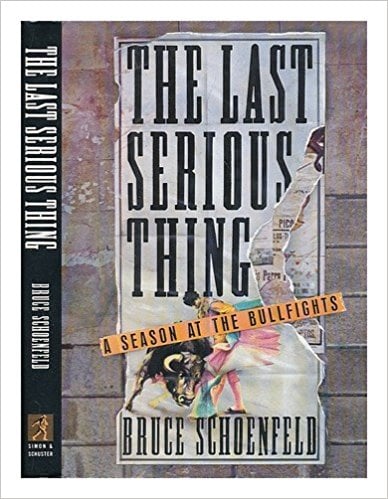The old man has done a bit of everything that a journalist can do. He has been an opera critic, a war correspondent, a sportswriter. He prides himself most on the years he spent covering the bullfights of his native Sevilla. For some time now he has been mumbling to his American visitor, Bruce Schoenfeld, who recalls the old man “speaking Spanish with such a harsh and peculiar accent that I can’t understand a word.” He remains incomprehensible until he stands before a group of fellow enthusiasts of the ancient sport of tauromachy. Then, in a voice as clear as day, he declares, “There have been too many words written about bullfighting already. . . . The last thing we aficionados need is another [book].”
That may be true in Spain, where the shelves brim with titles on the corrida. But because the sport is not practiced in the United States, American writers have spent a little ink writing about bullfighting, and there is plenty of room for new books on the subject. At the apex of our small literature stands Ernest Hemingway’s Death in the Afternoon, an indispensable consideration of the matador’s art; then there yawns a great gap between it and a mound of lesser works, including the same writer’s Dangerous Summer and the worshipful Or I’ll Dress You in Mourning, by the team of Larry Collins and Dominique LaPierre. Bruce Schoenfeld’s The Last Serious Thing occupies that hitherto empty middle ground.
Schoenfeld writes without pretense, fully aware that he will not equal Hemingway’s great treatise. Instead, he gives us plain-vanilla reportage on the people involved in bullfighting, from spectators to breeders to picadors. Unlike Hemingway, he seems to take little interest in technique; on the face of it, Schoenfeld wouldn’t know a paso doble from a veronica, although he surely does. What he has is a keen eye for everyday detail, and his book is as much about post-Franco Spain as it is about the ritualistic dispatch of infuriated beef.
Schoenfeld recounts a year’s sojourn in Sevilla, “the city of the bull.” (It is also a city where, as- any visitor will remember, no local ever seems to work or sleep, where the resaca, the hangover, is a paid holiday. Rio de Janeiro seems dour by comparison.) In the ancient city Schoenfeld finds no end of memorable characters with which to populate his book. Among them are Juan Antonio Ruiz, “the only true maxima figura currently active in bullfighting today,” who goes by the nickname Espartaeo, or Spartacus; a slew of British and American expatriates, who have collectively developed an encyclopedic knowledge of tauromachy past and present, to the consternation of turf-guarding Spaniards; and a retired banderillero called Navarrito, given even under the sternest years of Fascist rule to proclaiming his communist beliefs to the nearest policeman. Their stories, skillfully woven into the narrative, give real life to Schoenfeld’s book.
Schoenfeld is equally good on what might be called the politics of bullfighting. He notes that in Spain, democratic only since 1975, many identify the sport with the bloody pomp of the Franco regime and so shun it; only when a few leading officials of the Socialist Party began showing up at ringside in the mid-1980’s did the sport regain something of its former popularity. Like their grandparents, Spanish teenagers now accord matadors the same adulation as they do movie stars, pop musicians, and soccer pros, a nice bit of cultural continuity. Schoenfeld also notes the class-conditioned aspects of the corrida, where the poor entertain the rich, where “for every El Cordobes who gains financial security there are tens of thousands of aspirants who never see the inside of a bullring.”
Animal-rights activists, who are presumably politically correct enough to allow for multicultural relativity, have long decried bullfighting, one of the planet’s oldest sports. Schoenfeld seems to be neutral on the subject; he admits to neither a queasiness at the sight of spilled blood nor a sub-rosa thrill at the spectacle of sequined suits and flashing swords. Indeed, throughout the narrative he is curiously detached, and only the characters who wander in and out of his pages give them any sparkle. He reserves the final paragraph of his yeomanlike study to reveal any passion for the essence of the sport: “A human psyche laid bare, and the courage you need, in a plaza filled with thousands of people, to stand alone with yourself and the truest reality of all, the ubiquitous presence of death.” Would that the rest of The Last Serious Thing had attained such poetry.
[The Last Serious Thing: A Season at the Bullfights, by Bruce Schoenfeld (New York: Simon & Schuster) 238 pp., $22.00]

Leave a Reply